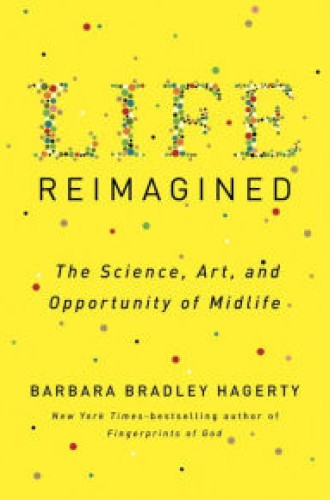Midlife happiness through the (narrow) lens of science
How can we live well after 40? asks Barbara Bradley Hagerty. She could have consulted the wisdom traditions.
Imagine if Aristotle, writing his Ethics, had narrowed his subject to people 40 and older, asking what human flourishing looks like in the second half of life. Then imagine he had access to neuroimaging technology and psychological research. The result might have been something like Life Reimagined. Barbara Bradley Hagerty critiques shallow notions of midlife happiness in her quest to understand midlife eudaimonia—human thriving, flourishing—using the best science on the topic.
Hagerty is known to many as National Public Radio’s former religion correspondent, a job that positioned her well to write her first book, Fingerprints of God: What Science Is Learning about the Brain and Spiritual Experience. Readers of that book will recognize in this one Hagerty’s penchant for allowing brain science to shed light on tough questions, in this case how to thrive in the years of midlife. Her adverting to neuroscience is at once a strength and a weakness of Life Reimagined.
Read our latest issue or browse back issues.
The book pieces together her own story of midlife struggle with stories of others and research on the science of midlife. (Early in the book she announces to her husband, “I think I’m having a midlife crisis,” to which he responds, “Please don’t do that.”) The result is a compelling mosaic of strategies for making the years between 40 and 60 rich and meaningful.
Among other things, she considers how to strengthen the midlife brain (stay socially active and learn something new); the importance of having a sense of purpose (short-term goals help the brain stay young); and the possibility of developing resilience in the face of midlife’s misadventures (we can learn to regulate our responses to difficult circumstances). Throughout the book her gifts as a journalist shine in one well-told story after another, which put flesh on the science.
Aristotle would have been happy with some of her findings. For instance, she concludes that friends are necessary for midlife flourishing, and loneliness is lethal. “Feeling lonely and isolated, no matter what your age, will shorten your life as much as smoking fifteen cigarettes a day.” She recounts one study in which subjects’ brains were scanned as they anticipated receiving mild electrical shocks to the ankle. The results showed that holding the hand of a trusted friend during the experiment calms the fear center of the brain. She concludes that friends are crucial when the pressures of midlife begin to converge. “Friends are no longer a luxury; they are a lifeline.”
The chapter on friendship shows the usefulness of neuroscientific studies. They confirm what we have long suspected: that our “brains are wired to make us dependent.” But the same chapter also highlights the limitations of such research, for friendship viewed from this scientific vantage point becomes pragmatic and strategic. There’s more here about why we need friends—friendship lowers blood pressure, boosts the immune system, and regulates stress hormones—than there is about what is required to be a good friend.
Perhaps that’s because being a friend might mean maintaining a relationship with someone who raises your blood pressure and even reduces your life span. A scientific account of flourishing would recommend ditching this friend.
This example reveals a lacuna in the book: it ignores what wisdom traditions, both religious and philosophical, have to say about living well at midlife. There’s little room in Hagerty’s utilitarian view of friendship, for instance, to lay down one’s life for a friend as Jesus taught.
The same hole is evident in the chapter on marriage. When midlife marriages end “they usually end with a whimper, when both sides stop trying, when they become disconnected and bored.” Brain scans have shown that our brains love novelty; thus, novelty might be the cure for a midlife marriage on the rocks. One study she reviewed showed that couples who engaged in new, interesting activities together, like taking dance lessons, rather than familiar, comfortable ones, like watching a movie, showed higher marital satisfaction and interest in each other. Her conclusion: inject novelty in the midlife marriage. After reading this chapter I announced to my wife that we need to take swing dance lessons again.
But I also wondered what Hagerty’s conclusion would have been if she’d listened to the Christian tradition’s warning about acedia, the restlessness that causes us to hanker for the new. Acedia tempts us to escape reality by distracting ourselves with novelty. For those couples who can’t afford dance lessons or don’t have the flexibility to rent an RV and travel the country as Hagerty and her husband did, might there be some wisdom in embracing rather than fleeing the relentless sameness that is midlife marriage?
I imagine many of Hagerty’s recommendations are sound: engage midlife with verve; be “all in”; learn something new; set a few goals; embrace challenge; invest in relationships. After finishing the book I got out my old Greek textbooks, determined to relearn the language, and I began practicing Debussy’s “Clair de Lune” on the piano, resolved to exploit my brain’s neuroplasticity to the fullest.
But I also realized that many of the people she writes about had privileges that allowed them to engage midlife the way they did. One woman learned Spanish and then lived for months in Costa Rica. Hagerty herself took a buy-out at NPR to focus on writing because her husband had a substantial income. Hagerty knows her audience—the educated, affluent, relatively mobile people who listen to NPR—and many of them have the means to approach midlife as she suggests. Even Aristotle knew that happiness requires some external goods.
But if the world’s wisdom traditions had been consulted, or even Hagerty’s own Christian tradition, there might have been an acknowledgment that flourishing involves embracing the reality of life as we find it, and perhaps even relinquishing some of the privileges that make possible so many of the lives she chronicles.







